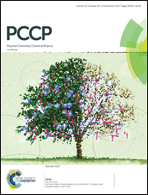A combined continuous wave electron paramagnetic resonance and DFT calculations of copper-doped 3∞[Cd0.98Cu0.02(prz-trz-ia)] metal–organic framework†
Abstract
Continuous wave X-band electron paramagnetic resonance (EPR) and density functional theory (DFT) were successfully applied to explore the incorporation and coordination state of the Cu2+ ions in the 3∞[Cd0.98Cu0.02(prz-trz-ia)] porous metal–organic frameworks. EPR measurements on powder samples and single crystals provided the full electron Zeeman g and copper hyperfine ACu interaction tensors including the orientation of their principal axes frames. DFT computations allowed for a detailed interpretation of the experimental results in terms of coordination symmetry and binding properties of the paramagnetic Cu2+ ions. Cupric ions were found to substitute Cd2+ ions in the dinuclear Cd–Cd units where they experience a noticeably distorted elongated pyramidal coordination environment formed by three nitrogen and two oxygen atoms from three linker molecules.
![Graphical abstract: A combined continuous wave electron paramagnetic resonance and DFT calculations of copper-doped 3∞[Cd0.98Cu0.02(prz-trz-ia)] metal–organic framework](/en/Image/Get?imageInfo.ImageType=GA&imageInfo.ImageIdentifier.ManuscriptID=C7CP06420A&imageInfo.ImageIdentifier.Year=2017)
- This article is part of the themed collection: 2017 PCCP HOT Articles


 Please wait while we load your content...
Please wait while we load your content...